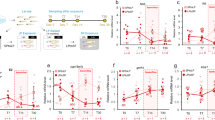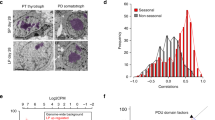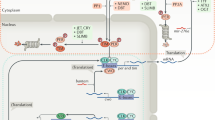Abstract
IN 1936 Bünning1,2 suggested that living organisms measured the length of the daily photoperiod by using an endogenous daily (circadian) rhythm which he envisaged as consisting of two half-cycles (the photophil followed by the scotophil) each of approximately 12 h duration2. Photoperiodic induction of a physiological process requiring long days occurred only when the duration of the natural photoperiod extended into the scotophil part of the endogenous cycle. A more explicit version of the Bünning hypothesis has been presented by Pittendrigh3,4, stressing the dual function of light in acting both as an entraining agent (or Zeitgeber) for the circadian oscillation and as the photoperiodic inducer. He has also emphasized that the “scotophil” may not last for a full 12 h and suggests the more restrictive term “photo-inducible phase” to refer to that portion of the daily oscillation which, if illuminated, leads to photoperiodic induction. There is now good evidence available to support Bünning's hypothesis in plants5,6, and in at least four species of finches where the photoperiodic induction of testicular growth also relies on a circadian rhythm7–16. The present studies in a Galliform species, the Japanese quail (Coturnix coturnix japonica)17–20, were undertaken not only to check whether a circadian oscillator was involved in the photo-periodic response mechanism of both sexes but also to measure the duration of the photo-inducible phase. Experiments on the latter seemed possible, for Coturnix shows an extremely high rate of gonadal development18.
This is a preview of subscription content, access via your institution
Access options
Subscribe to this journal
Receive 51 print issues and online access
$199.00 per year
only $3.90 per issue
Buy this article
- Purchase on Springer Link
- Instant access to full article PDF
Prices may be subject to local taxes which are calculated during checkout
Similar content being viewed by others
References
Bünning, E., Ber. Deutsch. Bot. Ges., 54, 590 (1936).
Bünning, E., Cold Spring Harbor Symp. Quant. Biol., 25, 249 (1960).
Pittendrigh, C. S., and Minis, D. H., Amer. Naturalist, 98, 261 (1964).
Pittendrigh, C. S., Z. Pflanzenphysiol., 54, 275 (1966).
Hamner, K. C., and Takimoto, A., Amer. Naturalist, 98, 295 (1964).
Hillman, W. S., Amer. Naturalist, 98, 323 (1964).
Hamner, W. M., Science, 142, 1294 (1963).
Hamner, W. M., Nature, 203, 1400 (1964).
Hamner, W. M., in Circadian Clocks (edit. by Aschoff, J.), 379 (North-Holland, Amsterdam, 1965).
Hamner, W. M., and Enright, J. T., J. Exp. Biol., 46, 43 (1967).
Farner, D. S., in Circadian Clocks (edit. by Aschoff, J.), 357 (North-Holland, Amsterdam, 1965).
Wolfson, A., Rec. Prog. Hormone Res., 22, 177 (1966).
Menaker, M., in Circadian Clocks (edit. by Aschoff, J.), 385 (North-Holland, Amsterdam, 1965).
Menaker, M., and Eskin, A., Science, 157, 1182 (1967).
Menaker, M., Proc. US Nat. Acad. Sci., 59, 414 (1968).
Menaker, M., and Keatts, H., Proc. US Nat. Acad. Sci., 60, 146 (1968).
Mather, F. B., and Wilson, W. O., Poultry Sci., 43, 860 (1964).
Follett, B. K., and Farner, D. S., Gen. Comp. Endocrinol., 7, 111 (1966).
Follett, B. K., and Farner, D. S., Gen. Comp. Endocrinol., 7, 125 (1966).
Konishi, T., Ishiguro, T., and Kato, M., Zool. Magazine, Tokyo, 74, 54 (1965).
Bünning, E., and Joerrens, G., Z. Naturforsch., 15b, 205 (1960).
Farner, D. S., and Follett, B. K., J. Animal. Sci., 25, Suppl. 90 (1966).
Adkisson, P. L., Science, 154, 3746 (1966).
Lofts, B., and Murton, R. K., J. Zool., 155, 327 (1968).
Ramirez, V. D., and Sawyer, C. H., Endocrinology, 76, 282 (1965).
Author information
Authors and Affiliations
Rights and permissions
About this article
Cite this article
FOLLETT, B., SHARP, P. Circadian Rhythmicity in Photoperiodically Induced Gonadotrophin Release and Gonadal Growth in the Quail. Nature 223, 968–971 (1969). https://doi.org/10.1038/223968b0
Received:
Revised:
Issue Date:
DOI: https://doi.org/10.1038/223968b0
This article is cited by
-
Seasonal regulation of the lncRNA LDAIR modulates self-protective behaviours during the breeding season
Nature Ecology & Evolution (2019)
-
Neural control of daily and seasonal timing of songbird migration
Journal of Comparative Physiology A (2017)
-
Light-induced hormone conversion of T4 to T3 regulates photoperiodic response of gonads in birds
Nature (2003)
-
Photoperiodic induction of ovarian growth and plasma estradiol secretion in a migratory finch, Emberiza melanocephala: Involvement of circadian rhythm
Acta Biologica Hungarica (2000)
-
Involvement of circadian rhythm in response to ultrashort photoperiods in blackheaded bunting, Emberiza melanocephala
Acta Biologica Hungarica (1997)
Comments
By submitting a comment you agree to abide by our Terms and Community Guidelines. If you find something abusive or that does not comply with our terms or guidelines please flag it as inappropriate.



